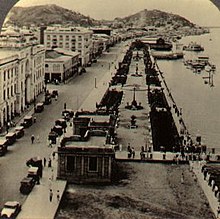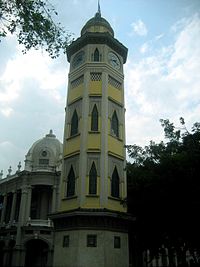|
Malecón 2000
 Malecón 2000 is the name given to the boardwalk overlooking the Guayas River in the Ecuadorian port city of Guayaquil. An urban renewal project focusing on the old Simón Bolívar boardwalk, it stands along the west shore of the river for an approximate length of 2.5 km. (1.5 mi.) Several of the greatest historical monuments in the history of Guayaquil can be seen along its length, as well as museums, gardens, fountains, shopping malls, restaurants, bars, food courts, the first IMAX theater in South America, as well as boarding docks where several embarkations offer both daytime and nighttime tours up and down the Guayas River. It is one of the largest works realized in Guayaquil and it is considered a model of urban regeneration by global standards, having been declared a healthy public space by the Pan-American Organization of Health (POH) and the World Health Organization (WHO). History During the colonial period, Malecón was a narrow path in roadway form. During the 19th century people started to gather around this place, gradually expanding its extension as years went by and it became a focal point of early social life in the young city. Over several decades, the boardwalk fell into disrepair with several areas of it eventually falling into the river itself by the mid-to-late 1980s. By this time it was also regarded as a very unsafe place, as many thieves, muggers and cutpurses took advantage of the cover provided by overgrown foliage and poor illumination to hide and wait for possible victims. Drug dealers and prostitutes also used to frequent the area at night during its most dangerous period. PresentInitiated during the administration of Mayor León Febres-Cordero, ex-president of the Republic of Ecuador, and finalized during the second term of his successor, Jaime Nebot Saadi, it held as one of its goals the re-valuation of the commercial areas of the city creating spaces that would encourage urban renewal, a goal that has been successful thanks to the leadership and commitment of the private sector. The Malecón now receives both national and foreign visitors who marvel at and enjoy its beauty and safety. At 5 million visitors since its first stage inauguration in October 1999, it is one of the most visited places in the city. It offers visitors a wide range of activities, varying from just plain fun, to cultural events as well as an opportunity to explore the natural resources Guayaquil has. It has a mall, a museum, infinity of restaurants, exhibition galleries, lagoons, and walk paths. The Malecón 2000 Foundation, a private non-profit entity, administers the boardwalk. This foundation is comprised by the most representative public and private entities in the city. LocationsSectionsMalecón 2000 is divided into several sections:
Monuments  As you walk you can also appreciate the monuments, some of them created in honor of important characters in the history of our country:
Recreational Areas
 GardensThe Malecón Gardens, are parks of approximately 22,000 m2. of extension, where visitors can enjoy different botanic species of Ecuador. It also has an artificial stream on Orellana street and a pond that spreads between Tomás Martinez and Loja streets. It has a pedestrian path ensemble, and this circuit has been adapted to the presence of the big existent trees, this zone is enhanced by extensive and profuse green areas. The walk in the Gardens, includes beautiful landscapes and rest areas supported by public spaces such as squares, small squares, miradors, gazebos, bleachers, jetties, pergolas. These spaces are supplemented with streams, lagoon, island, fountains, bridges, ramps and paths where activities related to the park such as scheduled exhibitions and sales of plants and souvenirs from The Malecón Gardens are developed. Museo AntropológicoAnother great place that every visitor and tourist should not miss is this great Museum of Anthropology (Museo Antropológico). It offers great expositions of local artists as well as international ones, the whole place gives an atmosphere of modern architecture and technology. Every week the works and events are updated to be presented to the public. Prices can vary from 50 cents to $1.50, depending on the event or what is being exposed. References and external linksWikimedia Commons has media related to Malecón 2000. |